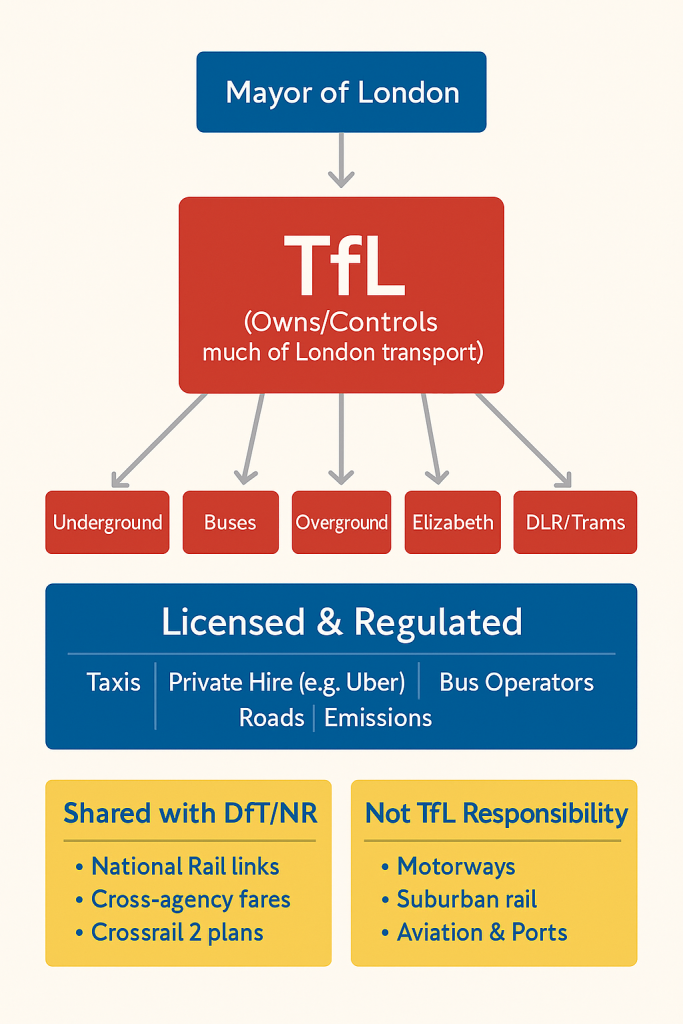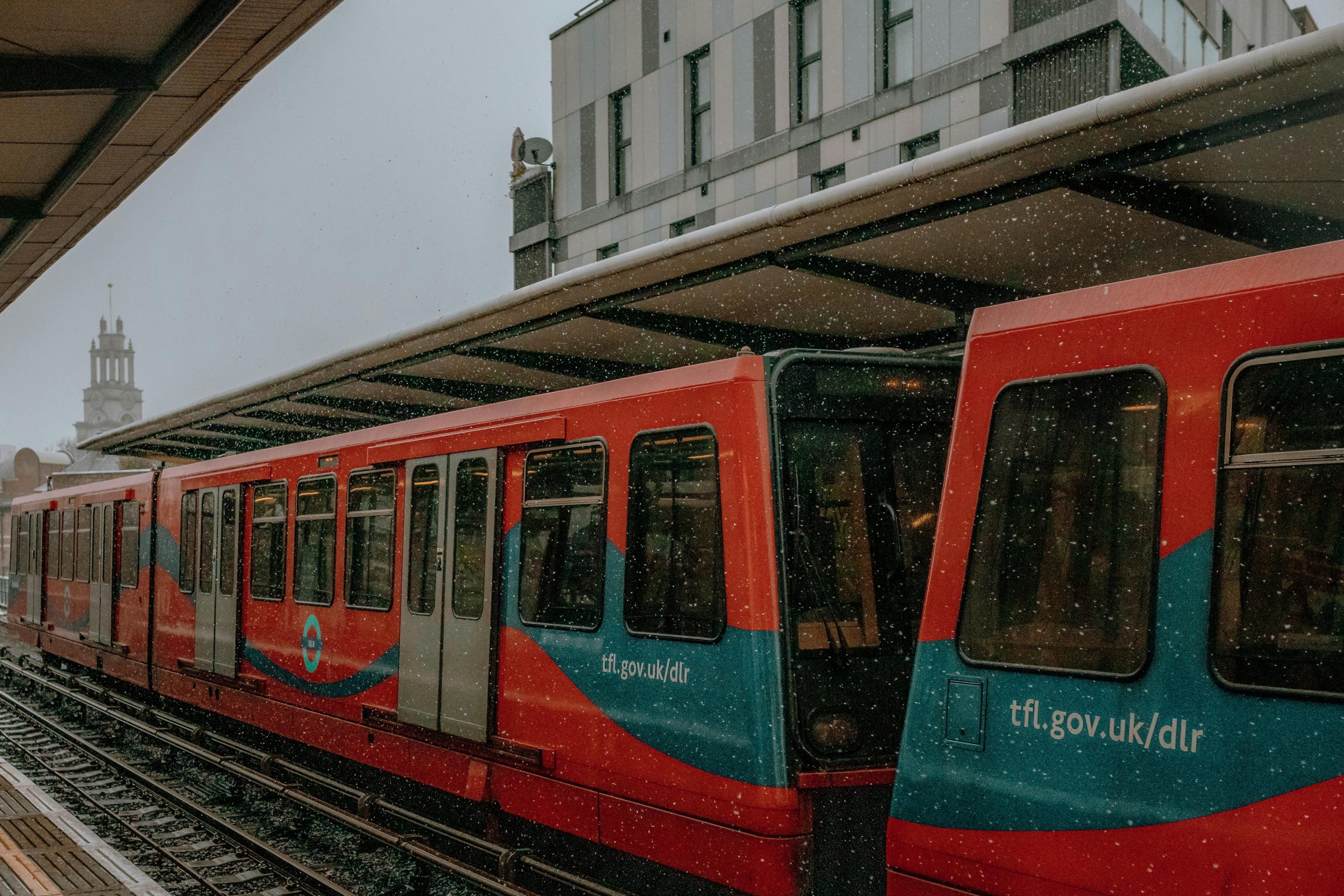Transport for London (TfL) is the public body responsible for most aspects of the transport system in Greater London, England. It was established in 2000 and operates under the authority of the Mayor of London.
Key Responsibilities of TfL:
🚌 Public Transport Management:
- London Underground (the Tube) – Oversees the world-famous underground railway network.
- London Buses – Operates over 8,000 buses across the capital.
- London Overground – Manages the orbital rail routes outside central London.
- Docklands Light Railway (DLR) – A driverless light metro in East and South-East London.
- Elizabeth Line (Crossrail) – A hybrid rail-tube service connecting Heathrow and the west to East London.
- Trams – Runs Tramlink services in South London (primarily Croydon).
🚦 Roads and Traffic:
- Maintains red routes, which are the main arteries in and out of London.
- Operates the Congestion Charge and Ultra Low Emission Zone (ULEZ).
- Manages traffic signals, cycle lanes, and pedestrian crossings.
🚲 Walking & Cycling:
- Runs the Santander Cycles (bike hire scheme).
- Promotes and develops walking routes and cycle superhighways.
- Oversees major projects like Liveable Neighbourhoods and Healthy Streets.
🚕 Licensing & Regulation:
- Licenses and regulates taxis (black cabs) and private hire vehicles (including Uber).
- Regulates the safety and standards of operators and drivers.
Funding:
TfL is funded through:
- Fares and ticket revenue
- Government grants
- Congestion & emission charges
- Commercial activity (e.g., advertising, property)
Importance:
TfL isn’t just a transit operator — it’s a central planner of mobility in London, influencing everything from infrastructure investment to air quality policy. It plays a vital role in shaping how people move, live, and work in the city.
🌐 TfL and National Rail: Coordination, Not Control
While TfL runs much of London’s public transport, National Rail services are run by separate train operating companies (TOCs) under contracts with the UK Government’s Department for Transport (DfT).
TfL’s Role in the Rail Ecosystem:
| TfL Service | Overlap with National Rail |
|---|---|
| London Overground | TfL took over underused National Rail routes and modernised them. Still uses National Rail tracks. |
| Elizabeth Line (Crossrail) | Partly runs on Network Rail infrastructure but branded and operated by TfL. |
| Travelcards/Oyster | Works across both TfL and National Rail zones within Greater London. |
| Rail Timetabling and Fares Integration | TfL collaborates with TOCs to simplify transfers and fares. |
| Rail Devolution | TfL has lobbied to take over more suburban rail services for better coordination, but this is politically sensitive. |
In short, TfL doesn’t own the whole network but works like an orchestra conductor, trying to align multiple services into a coherent system for passengers.
🏛️ TfL Governance Structure: Under the Mayor’s Eye
TfL is a statutory body, meaning it’s enshrined in law — specifically the Greater London Authority Act 1999.
Governance Chain:
- Mayor of London (e.g., Sadiq Khan)
- TfL Board
- Oversees TfL’s budget, investment, and key strategic decisions.
- Includes business leaders, public transport experts, and elected Assembly members.
- London Assembly
- Holds the Mayor and TfL to account.
- Can question decisions, investigate problems, and demand public transparency.
🧭 Strategic Powers and Constraints:
While TfL is powerful within London, it relies on national funding and approval for expansion projects like:
- New rail lines (e.g., Crossrail 2 — shelved for now).
- Changes to existing rail franchises.
- Emission zone enforcement powers.
This means collaboration with Whitehall (central government) is both essential and sometimes fraught with friction — especially when different political parties control the Mayor’s Office and Westminster.
🔧 In Summary:
Transport for London is part operator, part regulator, part visionary. It choreographs buses, trains, bikes, cars, and pedestrians across one of the most complex cities on Earth — but its performance is often limited by the rails it doesn’t own and the funding it doesn’t control.
Transport for London (TfL) was born from the Greater London Authority Act 1999, but the idea — the vision of a single, unified body overseeing all of London’s transport — was most strongly championed by Ken Livingstone, the first Mayor of London.
🧠 The Visionary: Ken Livingstone
- Ken Livingstone was elected as London’s first directly elected mayor in 2000, just as TfL was being formed.
- He had long advocated for bringing fragmented transport services under one roof — a reaction to:
- Privatised bus operators
- A complex and disjointed rail system
- No unified body responsible for making London’s transit user-friendly
“You can’t run a world-class city on a third-world transport system,” Livingstone once said, reflecting his belief that public transit should be centrally planned, affordable, and integrated.
🏗️ Predecessor Bodies: A Fragmented Past
Before TfL, London transport was split between:
| Body | Responsibilities |
|---|---|
| London Transport (LT) | Managed the Tube and buses until 2000 |
| British Rail / National Rail | Ran the suburban rail network |
| Local boroughs | Managed roads and cycling |
| Private companies | Operated many bus services post-1980s deregulation |
There was no cohesive authority tying them together. Travelcards barely worked across modes. Integration was a mess.
🏛️ Legislative Origin: The 1999 Act
- The Greater London Authority Act 1999, passed under Tony Blair’s Labour government, laid the legal groundwork for:
Though the legal framework came from Parliament, the political and practical implementation came from the Mayor’s Office — and Livingstone wasted no time.
📅 Key Timeline:
- 1999 – Greater London Authority Act passed.
- 2000 – TfL established as a legal entity.
- 2000 (May) – Ken Livingstone becomes Mayor.
- 2003 – Congestion Charge introduced.
- 2007 – TfL takes control of London Overground.
- 2010s – TfL expands into cycling, river services, and upgrades to Tube infrastructure.
✍️ Summary:
So whose idea was TfL?
The concept came from Parliament, but the soul and drive came from Ken Livingstone.
He took a legal framework and forged it into a living system, giving Londoners one of the most integrated transport authorities in the world — often against opposition, but always with the long view in mind.
🚦 TfL Direct Control (Owns, Operates, or Fully Manages)
| Service/System | Description |
|---|---|
| London Underground (Tube) | Full operational and infrastructure control. |
| London Buses | TfL doesn’t own buses but contracts private operators and sets routes, fares, and standards. |
| London Overground | Managed by TfL; operations contracted out (currently to Arriva Rail London). Branding, fares, and service levels set by TfL. |
| Elizabeth Line (Crossrail) | Owned by TfL, operated by MTR. Uses some National Rail tracks (e.g. between Paddington and Heathrow). |
| Docklands Light Railway (DLR) | Owned by TfL; operated by a private consortium. Fully automated trains. |
| London Trams (Croydon Tramlink) | Controlled by TfL; operations contracted out (currently to FirstGroup). |
| TfL Rail (legacy service) | Phased into Elizabeth Line. |
| Cycle Hire (Santander Cycles) | Owned and maintained by TfL. |
| Emissions Schemes | TfL operates the Congestion Charge, ULEZ, and LEZ. |
| Traffic Lights & Red Routes | Full control of over 6,000 traffic signals and key arterial roads. |
⚖️ TfL Regulation (Licenses, Sets Standards)
| Regulated Area | Authority |
|---|---|
| Black Cabs (Hackney Carriages) | Licensed and inspected by TfL. |
| Private Hire Vehicles (e.g., Uber, Bolt) | TfL issues licences and enforces safety standards. |
| Bus Operators | Must be contracted to TfL and meet strict service criteria. |
| Roadworks & Utilities | TfL regulates works on roads it manages to reduce disruption. |
🤝 TfL Shared or Interfacing Responsibility
| Shared System | TfL Role | Other Party |
|---|---|---|
| National Rail | Works with train operating companies (TOCs) for fare integration, station upgrades, and Travelcards. | Department for Transport (DfT) |
| Rail Infrastructure (e.g. Elizabeth Line outer sections) | TfL operates trains, but Network Rail owns/maintains tracks/stations. | Network Rail |
| Bus Stops and Shelters | TfL maintains most in Greater London, but some boroughs handle their own. | London Boroughs |
| Major Projects (e.g. Crossrail 2, HS2 links) | TfL co-plans, advocates, and provides consultation. | DfT, Treasury, local authorities |
| Airports | TfL interfaces with airport transit (e.g., Heathrow via Piccadilly Line/Elizabeth Line). | Airports are private or DfT-linked. |
❌ Not TfL’s Responsibility
| Not Managed by TfL | Managed by |
|---|---|
| Suburban/National Rail outside Greater London | Train operating companies (e.g., GWR, Southeastern) under DfT. |
| Motorways and major A-roads (e.g. M25) | National Highways (DfT agency). |
| UK-wide transport strategy | UK Government (Department for Transport). |
| Aviation, shipping, national freight | Not TfL territory. |
🧭 Summary Diagram


